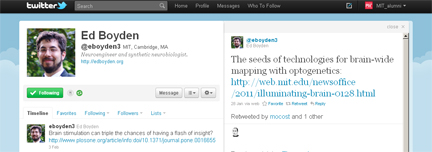Tweetin’ on Neurotech
-
-
slice.mit.edu
Filed Under
Recommended
 These 140-character glimpses into neurotechnologies and the culture of science are tweets posted by Edward Boyden ’99, MEng ’99, MIT associate professor of brain and cognitive sciences and of biological engineering. His tips range from the innards of cutting-edge science to “The geek has inherited the earth,” a link to an Atlantic article on the global elite, and “Why watching Comedy Central before grantwriting is a good idea.”
These 140-character glimpses into neurotechnologies and the culture of science are tweets posted by Edward Boyden ’99, MEng ’99, MIT associate professor of brain and cognitive sciences and of biological engineering. His tips range from the innards of cutting-edge science to “The geek has inherited the earth,” a link to an Atlantic article on the global elite, and “Why watching Comedy Central before grantwriting is a good idea.”
And besides his tweet flow, Boyden teaches, of course, and leads the MIT Synthetic Neurobiology Group. They have pioneered a new technique, called opto-fMRI, that builds on optogenetics—the genetic engineering of cells to respond to light, which allows scientists to selectively stimulate or silence individual nerve cells. Using this technique to gather and compare awake mouse data to human brain scans, researchers can learn a great deal about the underlying brain circuits involved in disorders such as epilepsy, schizophrenia, autism, and post-traumatic stress disorder. In 2010, the journal Nature Methods named optogenetics “Method of the Year.”
In an earlier Slice post, Boyden praised an MIT cultural phenomenon—the Undergraduate Research Opportunities Program: “UROP is not just an experience…It’s a way to have immediate impact on the lives of millions of people. I see UROP as the soul of MIT.”







